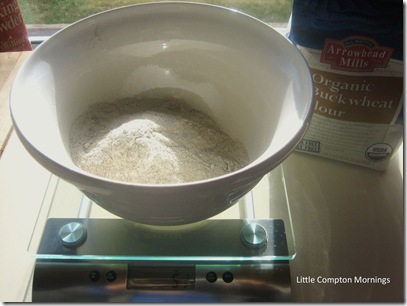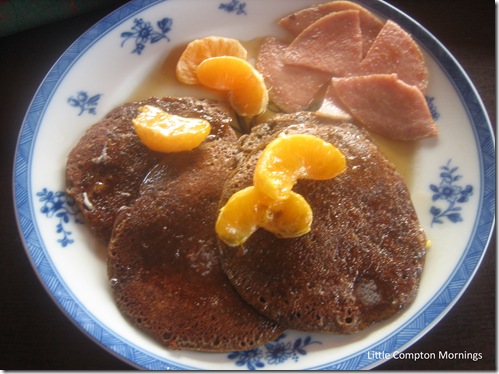
January in Rhode Island is for settling in and staying warm. To everything there is a season, and in this one, I lose interest in the luxury ingredients, complex menus, and rich preparations that mark the holidays. Like clockwork, I put them away for another year along with the holiday decorations, and begin to crave the cozy satisfaction of simple, homey, rib-sticking New England food.
For me, there is no mealtime so satisfying as breakfast, and none that lends itself so well to the old-fashioned without ever feeling like you want something lighter, trendier, more innovative. It is hard to improve on the idea of a pancake or jonnycake, or to even discuss doing so without sounding a bit silly. By all means, experiment with refining and rarifying dinner, but leave breakfast well enough alone.
An old favorite here in the Northeast is raised buckwheat pancakes. It just tastes like New England, in the same way that jonnycakes—a subject of a series of future posts--taste like Rhode Island. Many old-fashioned New England recipes call for buckwheat because it was widely grown here during the 18
th and 19
th centuries. In the mid-20
th century, however, it largely disappeared from local cultivation. In 1964, the last year for which there are statistics, only 57,000 acres were harvested nationwide, compared with over 1 million just 50 years earlier. One possible reason for this is that buckwheat does not lend itself to “improvement” through plant selection and other breeding techniques; grown primarily without pesticides or herbicides, its principal enemies are deer and other animals, much harder to control. (The upside of this is that when you eat a buckwheat pancake, it may be little changed from the one pioneer women served their families.) Another factor in declined production was likely changing tastes, as bleached white flour took over in mid 20th-century America. In the last 30 years, however, due to increasing demand for health reasons and for uses such as pillow fills, there has been some renewed interest in developing viable buckwheat strains for commercial farming.
Buckwheat is not wheat, not even a grain. It is an herbaceous summer annual, related to rhubarb and sorrel; this means that buckwheat has no gluten, a plus for those with wheat allergies—or those (not me) who have sworn off bread and pasta for the New Year. Some buckwheat is utilized in the form of groats (the crushed, de-hulled kernels); this is the well-known
kasha in the tasty Jewish dish, kasha varnitchkes (bow-tie noodles). Buckwheat flour is milled from the hulled triangular seed, and used for noodles (soba), porridge (from a coarser grit), a thickener for gravies and soups, and, of course,
pancakes and blini. Buckwheat also is the source of wonderful dark honey (some beekeepers plant it specifically for this reason), which now commands a high price because of the crop’s scarcity.
Nutritionally, buckwheat is the best source of high-quality protein of all plants (better than soybeans), containing all eight essential amino acids. It is also a good source of complex carbohydrates, insoluble fiber, potassium, iron, and B vitamins. Buckwheat has beneficial effects to circulation and may help lower cholesterol and diabetes risk. To benefit from buckwheat’s wholesome profile, be sure your buckwheat is very fresh; buy small quantities and use it as quickly as possible, freezing any extra, because it is high in fat and can go rancid quickly. Also make sure you are buying 100% buckwheat flour, as it is often packed as a mix for pancakes that includes wheat flour.
Rhody-style Buckwheat Pancakes
You may be surprised, from the looks of the batter, how light these are. They have a slightly sweet, slightly nutty taste that is quite unusual. I like the taste of orange with them, and sometimes serve them with
my orange-scented fig jam as well as with the tangerine-maple syrup here. Start these the night before; they are traditionally made in a pitcher for pouring out next day.
Serves 4.
½ cup Rhode Island
jonnycake cornmeal (see sources in left column)

¾ cup boiling water
1 ½ cups buckwheat flour
¼ tea salt
1 cup whole milk, scalded
2 ¼ tea active dry yeast (1 envelope)
¼ cup warm water
1 T molasses
2 T warm water
scant ½ tea baking soda
extra milk if needed
2/3 cup 100% maple syrup

1 tangerine, peeled and sectioned
butter
In a pitcher or medium bowl with a pouring spout, pour the boiling water over the cornmeal and stir to a mush. Add the buckwheat flour, salt, and scalded milk, and beat well with a wooden spoon to incorporate and remove any lumps. Set aside until lukewarm.
Dissolve the yeast in the warm water and add to the flour-cornmeal mixture, stirring well. It will look a bit like wet sand or, truth be told, wet concrete, belying its ultimate texture. Cover, and let sit on the counter in a draft-free place overnight. Next morning, dissolve the baking soda into the water and add with the molasses to the bubbly batter, stirring well to combine; you can add a few tablespoons of milk to thin it if you think it is too thick. (If it looks as if the batter fell after rising, not to worry.)
Heat a griddle to medium heat and grease with butter or shortening. Pour the batter into 4-5”rounds. Do not turn until the tops look relatively dry and you can easily slide the spatula under the full breadth of the pancake, or they will break. Turn only once and finish cooking the other side; they will be nicely brown.
While the pancakes are cooking, put the maple syrup into a small saucepan. Squeeze a few sections of tangerine into the syrup, and drop the rest into the pan. Place over low heat for a few minutes. Butter the pancakes and pour the warm tangerine-maple syrup over them to serve.

